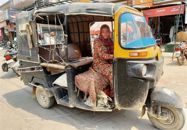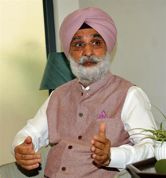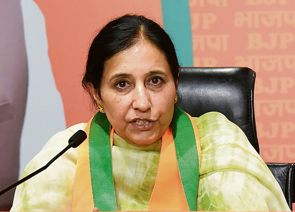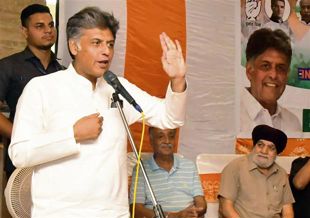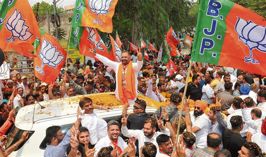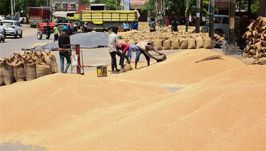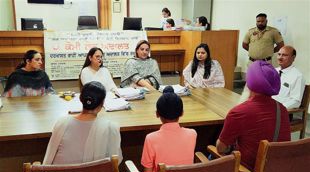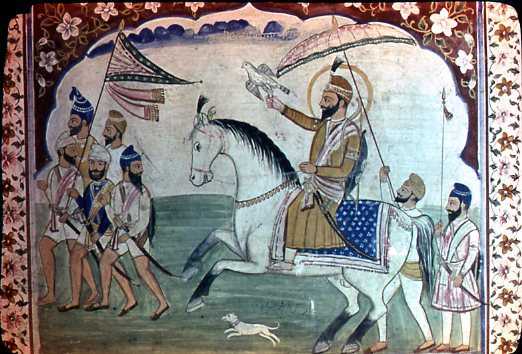
A mural panel from the temple of bairagis at Ram Tatwali in Hoshiarpur depicts Guru Gobind Singh on horseback
Kanwarjit Singh Kang
In the 17th and 18th centuries, the Sikhs and Hindus in Punjab had devoted themselves to their own preservation. The conditions of their life having undergone a considerable change since the emergence of Ranjit Singh, an opportunity came for encouraging visual arts, particularly murals. They started devoting themselves to the magnificence and splendour of their shrines. The endowments and eleemosynary grants worth thousands of rupees were provided for these shrines to be built in pacca masonry. Contributions began flowing in the form of money, produce and labour by the Sikhs and the Hindus for the construction of these shrines. Many individuals got murals made on certain portions of the walls.
The murals painted in the 19th-century Punjab covered a considerable range of themes. Representation of the Sikh Gurus constituted a major part and more than half of the murals portrayed Guru Nanak Dev and Guru Gobind Singh, the first and the last of the Sikh Gurus.
Among the surviving murals, Guru Gobind Singh — whose 350th birth anniversary celebrations are ongoing in Patna — is mostly depicted riding on a horseback, holding a falcon and accompanied by a hound and a few attendants. The best extant mural on this theme, which is repeated over and over again, is to be seen at the Golden Temple in Amritsar and at the samadh of Baba Dyal Das in Barnala. At the Golden Temple, this mural is painted on the wall behind the northern narrow stairway leading to the top of the shrine. According to late Bhai Gian Singh Naqqash, a painter belonging to the family of mural painters, this mural was painted by a Kangra artist specially commissioned by Maharaja Ranjit Singh for this purpose. It is said to be a true copy of a miniature painting that originally was in the collection of Raja Sansar Chand of Kangra and Maharaja Ranjit Singh had intended to get copied in the form of a mural at the Golden Temple. Since the artist of the miniature in question had already died, the mural was executed by the painter’s grandson. The name of the painter, however, is not known.
Guru Gobind Singh baptising the ‘Five Beloved Ones’ is another popular theme and one of its representative examples was extant on a wall of Sri Akal Takht at Amritsar before Operation Bluestar. An inscription on this mural in Gurumukhi characters read: “Panja Sighan Nu Amrit Chhakaya Sahib Dasween Padshahi Guru Gobind Singh Ji Ne”. The Panj Piare stood with folded hands before the Guru and Guru’s wife brought patashas (sugar crystals), which were put in an iron bowl and stirred with a two-edged sword by the Guru to make Amrit, the nectar of immortality.
An example of this theme can be seen in one of the murals at the samadh of Baba Mohar Singh, founder of the Dera of Nirmala Sadhus, located at Tanda in district Hoshiarpur. Another mural in this samadh depicts Guru Gobind Singh sitting along with his four sons.
In one of the murals at Gurdwara Gurusar in Bargari, a village on Faridkot-Bathinda road, Guru Gobind Singh was portrayed playing dice with Rai Jagga, the chief of Kotkapura.
At Gurdwara Sis Ganj in Anandpur Sahib, a mural illustrated Gobind Singh receiving the severed head of his father, Guru Tegh Bahadur, the former barely nine years old. Guru Tegh Bahadur was beheaded at Chandni Chowk in Delhi and his severed head was secretly carried by Bhai Jaita to Anandpur Sahib where obsequies were performed. With the renovation of the Gurdwara, this mural became extinct.
Guru Gobind Singh also appears on the walls of many shrines where repousse plaques were used for embellishment. At Gurdwara Baba Atal in Amritsar, Guru Gobind Singh appears in four repousse plaques: the first illustrating the Guru on horseback, holding a falcon and accompanied by a hound and five attendants; the second portrays the Guru baptising the ‘Five Beloved Ones’; the third depicts the Guru sitting on a throne, seated behind him are the Panj Piare and before him stand his four sons and devotees; the fourth represents him on horseback inspiring his followers with the conviction, Nischey kar apni jeet karun.
Unfortunately, most of the murals in Punjab have perished and those that are surviving are fast decaying.







